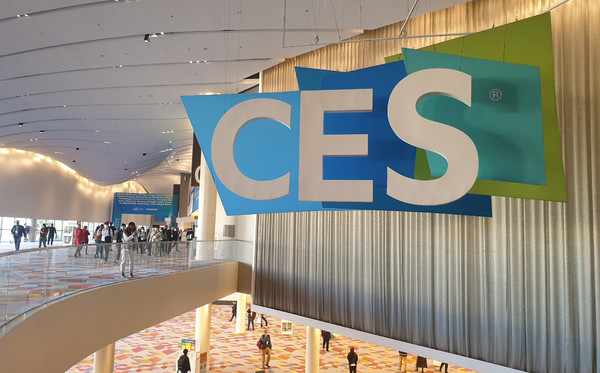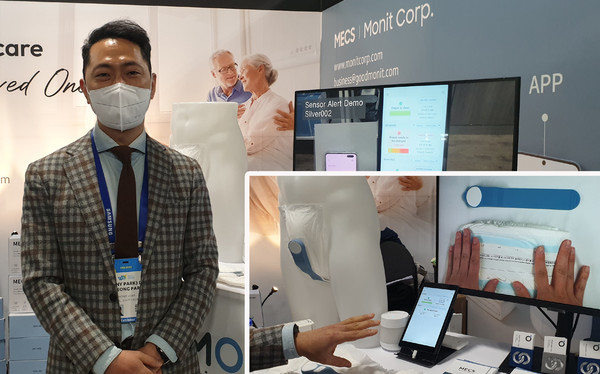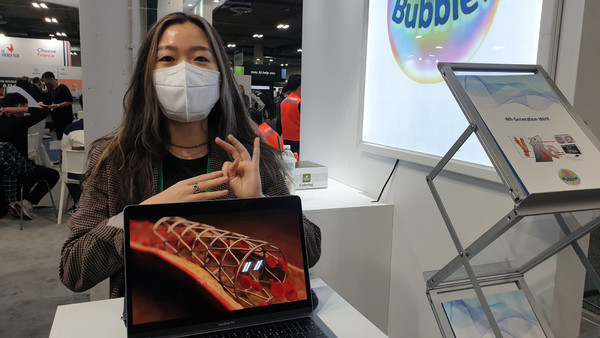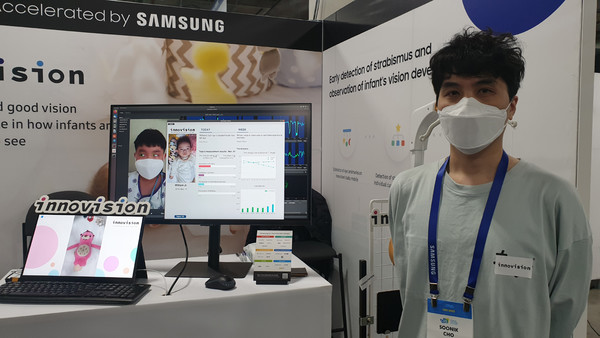LAS VEGAS, Nev. -- Aside from U.S. companies, Korean businesses were most visible during the CES (Consumer Electronics Show) 2022, the world's largest IT and electronics exhibition held offline after two years.

About 500 Korean companies participated in this year's CES, held from Jan. 5-7 in Las Vegas. The figure marked the largest ever, and 58 percent were startups, including digital healthcare firms.
At the Eureka Park in the Venetian Expo, the Korea Biomedical Review met various Korean digital healthcare startups armed with brilliant ideas and technology.

'Smart sensor' that tells when to change elderly patients’ diapers
Monit, a Samsung Electronics spin-off company, presented Monit Elderly Care System (MECS). This system notifies the time to change diapers for elderly patients at nursing hospitals and their caregivers.
By attaching a strap with a smart sensor to the outside of a diaper, the device detects the level of contamination and notifies the time of replacement.
Six sensors are attached to the strap, and the sensors send the signal intuitively. For example, the sensors notify when to change diapers through a lamp installed next to the bed and through a mobile application. The system also allows the hospital to check the overall situation in the center.
According to the company, MECS reduces the risk of urinary tract infections, rashes, and bedsores due to missed diaper changes, decreasing unnecessary changes and cutting down diaper use by about 25 percent.
The company launched the product in Japan in December and planned to release it in Korea in March.
"Some of our staffs received field training to obtain a nursing license," Monit CEO Park Do-hyung said. "They found changing diapers most difficult. They had to check and replace diapers every two hours, but it was hard to keep such schedules in the actual field.”
If caregivers use MECS, they can reduce the occurrence of urinary tract infections, rashes, and bedsores because it notifies the appropriate replacement time, which has great medical significance as well, Park added.
“We plan to release the system as a wellness device and take the necessary process to obtain a license as a medical device and health insurance benefits to have business feasibility in Korea,” he said.
Park stressed that the company would make MECS a digital therapeutic in due process.

‘4th-generation stent’ that opens blocked blood vessels using air bubbles
Bubbler introduced a fourth-generation stent.
Stents used for coronary intervention currently have three types -- metal (first generation), drug release (second generation), and biodegradable (third generation). However, conventional stents can cause side effects such as restenosis, thrombosis, or inflammation.
Bubbler used calcium carbonate to overcome the shortcomings of the existing stent. The stent covers the nozzle, manufactured through a 3D printer, with calcium carbonate. When inserted into blood vessels, the stent creates microscopic carbon dioxide bubbles to remove fatty plaques blocking the blood vessels. The company is testing the device using animal models.
"Carbon dioxide microbubbles dislodge fatty plaque blocking the blood vessels," Bubbler CEO Yoon Eun-hye said. "As the stent removes fatty plaque with physical force, it can resolve the side effect of restenosis."
After inserting the stent, hospitals can conduct regular checkups through a non-invasive procedure as they can use an ultrasound device, she added. In addition, the company will conduct clinical trials targeting the cardiovascular system after confirming the stent's safety through the ongoing animal trials.

‘Innovision’ detects squint among infants early
Early detection of strabismus in infants is difficult.
That was also why Cho Soon-ik, a Samsung Electronics engineer, developed “Innovision.” Cho’s son showed abnormal symptoms around 14 months after birth but had to receive surgery only when he was 27 months old.
Innovision monitors the baby's eyes with a camera on the mobile placed above cribs, strollers, or car seats.
While it is easy to miss strabismus in the early stages as symptoms appear in a quick moment, the device allows parents to photograph their baby's eyes for analysis continuously.
Cho is also developing a technology to check the severity of symptoms through a scoring system intuitively.
Samsung Electronics' C Lab Inside, its in-house venture program, has selected Innovision as one of its tasks and helped commercialize Cho's idea.
"While continuously shooting the eyes of the child with the camera inside the baby mobile, the system identifies the distance between the pupils, the angle of the line connecting the centers, and the range of motion to determine whether strabismus symptoms occur," Innovision CEO Cho said. "We started developing the system six months ago and are also developing a system that delivers necessary data to doctors."
However, commercialization will take some time, Cho added.

